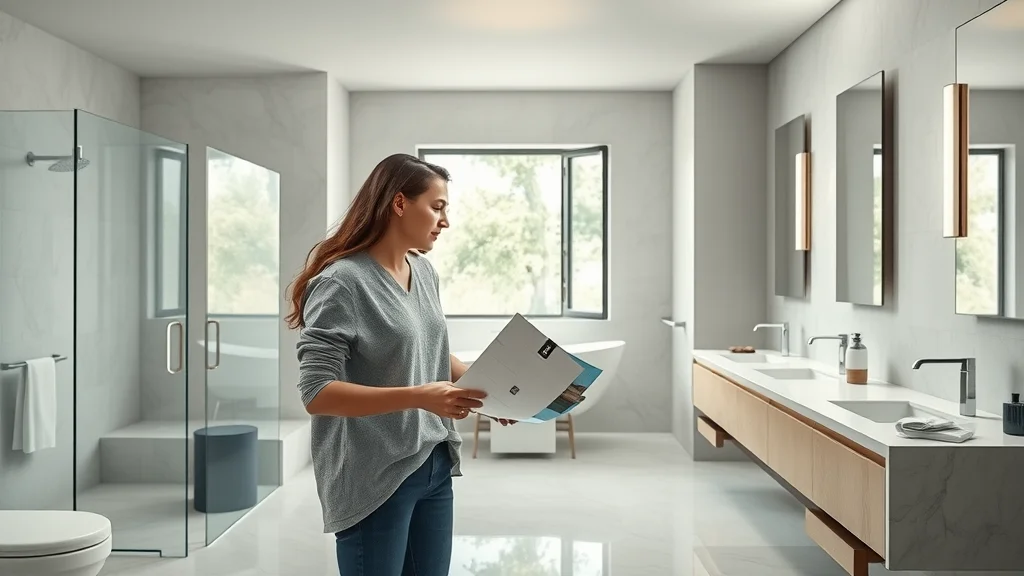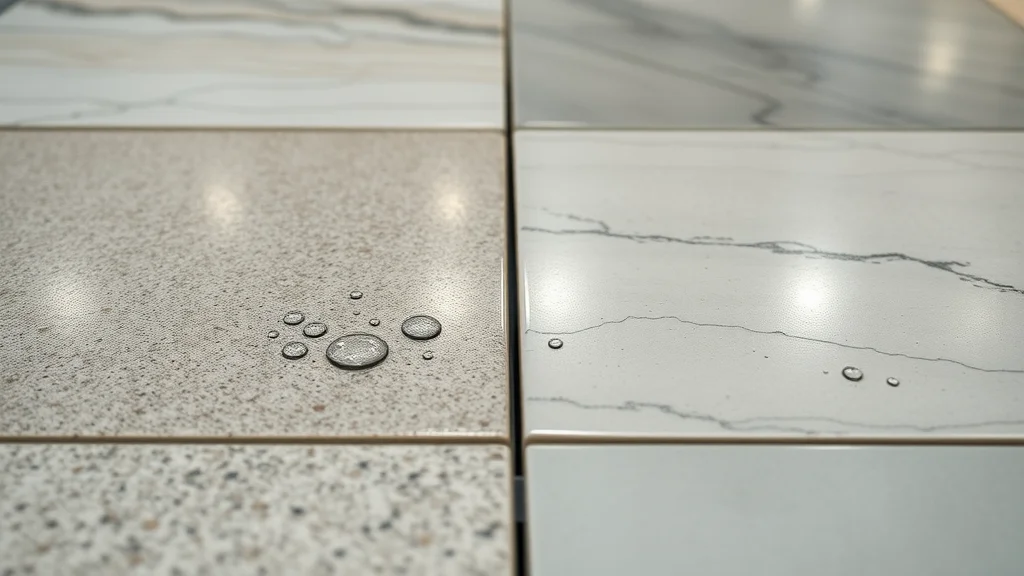Ever wondered if bathroom tiles are truly the best option for your luxurious bathroom remodel—or if there’s a better alternative hidden among the latest trends? This guide goes beyond the surface, uncovering the real-world pros and cons of bathroom tiles to help you create a space that’s as stunning as it is practical.
Are Bathroom Tiles the Right Fit for Your Bathroom Remodel?
When deciding on the ideal bathroom flooring for your remodel, tiles rise to the forefront as a popular choice, especially for those targeting a sophisticated yet functional upgrade. Bathroom tiles offer a wide range of tile options, including ceramic tile, porcelain tiles, marble tile, and vinyl tile, providing versatility that fits nearly any design vision. For luxury home renovations, where attention to both style and longevity is vital, examining the pros and cons of bathroom tiles ensures every decision is well-informed and tailored to your needs.
Many homeowners gravitate toward tile flooring because of its resilience in wet areas like bathrooms. However, there’s more to consider than aesthetics or water resistance alone. Owners of high-end residences must ponder wear and tear, maintenance demands, comfort underfoot, and installation costs. Each tile type brings unique strengths and weaknesses, from the timeless appeal of marble to the budget-friendly, low-maintenance benefits of vinyl tile. Choosing the right option requires balancing luxury, durability, practicality, and budget—all while ensuring your new bathroom floor stands the test of daily use.
Exploring the Pros and Cons of Bathroom Tiles in Luxury Home Renovations
In the context of luxury home renovations, every detail matters. Bathroom tiles not only impact the visual narrative of your space but also dramatically influence long-term functionality. Upgrading to ceramic tile or marble tile can instantly elevate your remodel with enhanced design customization and a bespoke ambiance. However, these materials demand thoughtful planning and sometimes intricate installation. While tile floors promise longevity and easy maintenance, they may also require specialized cleaning—especially in high-traffic bathrooms or those with vibrant design schemes.
For discerning homeowners, the question isn’t just about which floor tiles look best. Instead, it’s about understanding the nuanced pros and cons of each tile type, from slip resistance to comfort and sustainability. Luxury remodels often integrate radiant heating or unique inlays, requiring close attention to tile compatibility. Working with experienced professionals, like those at Banner Construction, can help turn your bathroom remodel from a standard update into a truly exceptional living space. Ultimately, your choice of bathroom tile sets the foundation for comfort, elegance, and everyday function.

What You’ll Learn About the Pros and Cons of Bathroom Tiles
-
Understand the key benefits and drawbacks of bathroom tile options
-
Gain insights into ceramic tile, tile floor, and tile flooring types
-
Explore criteria for superior bathroom floor and bathroom flooring choices
-
Navigate maintenance, cost, and design factors for your bathroom remodel
Bathroom Tile Materials: An Expert Overview
Navigating the variety of tile materials on the market is a pivotal first step in any bathroom remodel. You’ll encounter a spectrum of bathroom tile types—from the reliably classic ceramic tiles to resilient porcelain tiles, opulent marble tiles, and innovative vinyl tile flooring options. Each tile type is engineered for particular strengths, making it crucial to align your selection with both your lifestyle and your design ambitions. The right bathroom tile option not only sets the visual tone but also determines daily comfort, maintenance routine, and long-term value.
For upper income homeowners with a discerning eye, choices such as marble tile or large-format porcelain tiles are often appealing thanks to their elegance and durability. Vinyl tile and modern ceramic tile, on the other hand, introduce a balance of cost-effectiveness and practicality—without compromising on beauty. Banner Construction’s decades of expertise ensures that every client, regardless of preference or budget, enjoys a tailored solution rooted in quality and careful craftsmanship.
Ceramic Tile vs. Porcelain Tiles: Choosing the Best for Bathroom Flooring
Ceramic tile and porcelain tiles are often compared due to their similar aesthetics but distinct performance profiles. Ceramic tiles, made from a mixture of water, sand, and clay, are fired at slightly lower temperatures, resulting in a somewhat softer, more porous finish. These tiles offer a wide range of colors, finishes, and sizes, making them a popular choice for those prioritizing versatility. However, ceramic tiles are best suited for areas with moderate wear and should be properly sealed to maximize water resistance in wet areas like the bathroom floor or shower wall.
Porcelain tiles, meanwhile, are denser and fired at higher temperatures, producing a harder, less porous surface. This strength lends itself to high-traffic tile flooring where resilience to wear and tear is paramount. While porcelain tiles can often mimic natural stone or even wood, they may cost more upfront and require professional installation for optimal results. When choosing between ceramic tile and porcelain, consider your bathroom’s anticipated use, desired maintenance routine, and comfort needs—integral steps to achieving both style and function in your bathroom flooring.

Marble Tile, Vinyl Tile, and Other Popular Tile Types for Bathroom Remodeling
Marble tile stands as a top-tier choice for luxury bathroom installs, infusing elegance and classic charm into any remodel. However, marble tiles require more maintenance due to their porous nature and sensitivity to acidic cleaners or standing water, making sealing and regular upkeep essential. The aesthetic appeal and distinct veining patterns make marble tiles a designer favorite for feature bathroom floors or accent walls. In contrast, vinyl tile and vinyl tiles offer homeowners looking for a budget-friendly option considerable advantages. These newer generations of vinyl tiles can convincingly mimic higher-end materials, are easy to install, and provide notable comfort and warmth underfoot—a bonus in colder climates.
Other trending materials include slate, travertine, and engineered stone composite tiles, each with their own set of performance traits and visual impacts. Modern tile types aim to deliver long-lasting durability, easier cleaning, and a broader palette of design possibilities. Consulting with a professional team helps you weigh the suitability of each flooring option for your daily needs and style preferences, ensuring that your final choice will result in a bathroom that looks impeccable and stands the test of time.
“Selecting the right bathroom tile is more than a design choice—it’s about durability and longevity.” – Banner Construction Design Team
The Multifaceted Pros of Bathroom Tiles
-
Aesthetic versatility and design customization in tile flooring
-
Exceptional durability: Tile floor longevity for high-traffic areas
-
Easy maintenance and superior hygiene for bathroom floor surfaces
-
Water resistance advantages in bathroom tile installations

One of the leading reasons homeowners flock to tile flooring for bathroom remodels is the remarkable range of designs, patterns, and finishes available. From traditional subway tiles to modern geometric mosaics, tile floors enable full creative expression while supporting the unique attributes of any home’s architectural style. The wide range of colors and materials means you can create a bathroom environment that’s sleek and minimalist or bold and colorful—whatever best suits your lifestyle.
In addition to design flexibility, tiles are made to last. Ceramic and porcelain tile floors stand up well to daily foot traffic, resisting scratches and dents even in busy family bathrooms. Their non-porous surfaces promote superior hygiene and easy cleaning, especially important for busy households. Tiles also excel in resisting water intrusion—a critical feature in wet areas like showers and tubs. When installed and maintained correctly, bathroom tiles can serve you beautifully and reliably for many years, making them a practical choice for those seeking both style and substance.
Understanding the Cons of Bathroom Tiles: Room for Improvement?
-
Cold and hard surfaces: Comfort considerations for tile flooring
-
Grout maintenance and challenges for busy homeowners
-
Slippery when wet: Bathroom floor safety risks
-
Higher installation and repair costs for certain bathroom tile types

While the strengths of bedroom tiles make them a popular choice, they are not without their setbacks. A primary concern for many is comfort—tile floors can feel unforgivingly cold and hard under bare feet, especially in cooler climates or winter months. This can detract from the cozy feel many seek in a bathroom retreat but can be mitigated by integrating radiant in-floor heating. Another consideration is ongoing maintenance. While the tiles themselves are often low-maintenance, the grout that holds them in place can become stained or harbor mildew, requiring routine cleaning and sometimes resealing to keep your bathroom floor looking fresh.
Safety and costs are other factors to weigh. Many tile flooring options, especially those with glazed or polished finishes, can be slippery when wet—a particular concern for families with young children or elderly relatives. Higher quality materials like marble tile or intricate mosaic designs also come with steeper installation and repair price tags. Professional installation is highly recommended to ensure lasting performance, which may increase the initial investment. Weighing the pros and cons of bathroom tiles helps you make a confident, informed decision grounded in everyday realities.
Table: Comparing Bathroom Tile Types—Pros and Cons at a Glance
|
Tile Type |
Durability |
Cost |
Design Options |
Maintenance |
|---|---|---|---|---|
|
Ceramic Tile |
Good for moderate use; some wear and tear |
$$ |
Wide range; many styles |
Easy, needs sealing in wet areas |
|
Porcelain Tiles |
Excellent for high-traffic; robust |
$$$ |
Extensive; mimics stone or wood |
Low; grout needs upkeep |
|
Marble Tile |
High but prone to staining |
$$$$ |
Unique, luxury appeal |
Frequent sealing and gentle cleaning |
|
Vinyl Tile |
Good; softer underfoot |
$ |
Varied, budget-friendly |
Very easy |
Watch as an expert host guides you through the keypros and cons of bathroom tilesin a modern showroom—complete with real samples and installation footage to help visualize each option in action.
Professional Tips: How to Select the Ideal Bathroom Tile for Your Remodel
-
Assess your bathroom flooring needs and priorities:
Consider who uses the space, frequency of use, and key requirements (ease of cleaning, anti-slip properties, etc.). Think about how certain tile types align with the level of wear and tear expected in your home’s busiest wet areas. -
Align tile type with available budget and design vision:
Evaluate what styles resonate with your preferences. Establish a clear budget not just for materials, but for professional installation and future upkeep. Remember, investing in premium tile flooring or natural stone may increase home value and satisfaction. -
Balance aesthetics with easy maintenance and long-term value:
Select tile options that bring together beauty, comfort, and practicality. For those interested in radiant heating or low-maintenance living, certain vinyl tile and porcelain tile types offer particular advantages, while others require more hands-on care.

“Luxury is in every detail—choose your bathroom tile with intention for a space that reflects your lifestyle.” – Senior Remodel Specialist, Banner Construction
People Also Ask: Common Questions About the Pros and Cons of Bathroom Tiles
Is tile in the bathroom a good idea?
Answer:Bathroom tiles are favored for their water resistance, durability, and easy maintenance, making them an excellent choice for bathroom flooring. Their versatility accommodates many design styles, but it’s important to weigh comfort and budget considerations.
What is the 1 3 rule for tiles?
Answer:The 1/3 rule for tiles refers to offsetting rectangular tiles by one-third the length of the tile, instead of half, to minimize lippage and create a more natural, staggered appearance on the bathroom floor.

What are the negatives of tile flooring?
Answer:Tile flooring, including ceramic tile and porcelain tiles, can be hard, cold, and potentially slippery. Grout upkeep and repair costs may also be higher compared to other bathroom flooring options.
Is a fully tiled bathroom a good idea?
Answer:A fully tiled bathroom offers comprehensive water protection and visual cohesion but may lead to increased costs and a colder ambiance. Homeowners should consider heated tile floor options and design preferences during a bathroom remodel.
Discover the intricate detail and craftsmanship that goes into a high-end bathroom tile installation—watch a luxury bathroom transformation unfold from subfloor prep to the final grout polish.
FAQs: Pros and Cons of Bathroom Tiles
-
How do I maintain my bathroom tile floor to keep it looking new?
Regular sweeping, prompt spill cleanup, and periodic mopping with a mild cleaner are key for most tile floors. For grout lines, use a specialized brush and grout sealer as needed to prevent staining. -
Do certain bathroom tile materials last longer than others?
Porcelain tiles and some natural stone tiles, such as granite, are known for exceptional durability and resistance to wear and tear. Marble tiles, while beautiful, require more care and maintenance over time. -
Can bathroom tiles be used with underfloor heating systems?
Yes, most ceramic tiles, porcelain tiles, and even luxury vinyl tiles are compatible with radiant heating systems, providing a comfortable, warm surface in any climate.
Key Takeaways: Pros and Cons of Bathroom Tiles for Remodeling
-
Bathroom tile offers durability and versatility but requires proper installation and maintenance
-
Design, comfort, and budget must all be balanced for an optimal bathroom remodel
Moving Forward: Let Banner Construction Create Your Dream Bathroom
Transform your home with Banner Construction’s expert bathroom remodeling—call us at(314) 648-2368 to schedule your consultation today!
With the right knowledge of the pros and cons of bathroom tiles, you’re better prepared to choose a bathroom flooring solution that delivers both lasting beauty and everyday reliability. Let Banner Construction guide you every step of the way.
When considering bathroom tiles for your remodel, it’s essential to weigh their advantages and disadvantages to make an informed decision.
Pros of Bathroom Tiles:
-
Water Resistance: Tiles, especially ceramic and porcelain, offer excellent protection against moisture, making them ideal for humid environments like bathrooms. (magicbricks.com)
-
Durability: High-quality tiles can last for decades without cracking or fading, providing a long-term investment for your home. (magicbricks.com)
-
Aesthetic Versatility: With a vast range of colors, patterns, and finishes, tiles allow for full creative expression to match any design vision. (freestandingbath.co.uk)
-
Easy Maintenance: Tiles are simple to clean and generally resist stains, mold, and mildew with regular upkeep. (magicbricks.com)
Cons of Bathroom Tiles:
-
Cold and Hard Surface: Tiles can feel cold and hard underfoot, which may not be comfortable, especially during colder months. (pulsekitchens.com.au)
-
Slipperiness: When wet, tiles can become slippery, posing a risk for slips and falls. Opting for textured or slip-resistant tiles can mitigate this issue. (pulsekitchens.com.au)
-
Grout Maintenance: Grout lines can be susceptible to staining and mildew, requiring regular cleaning and sealing. (pulsekitchens.com.au)
-
Installation and Repair Costs: Tiling can be labor-intensive and costly, especially if professional installation is required. Additionally, repairing damaged tiles may involve replacing entire sections. (magicbricks.com)
By carefully considering these factors, you can choose bathroom tiles that align with your aesthetic preferences, functional needs, and budget.
